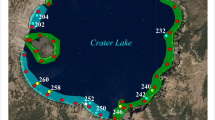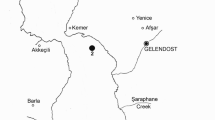Abstract
An empirical study was conducted on the effects of an introduced predator–prey pair, largemouth bass and bluegill, on pelagic productivity in 22 ponds in central Japan. In the univariate analysis, the effect of fish invasion on chlorophyll concentration was not evident, primarily because this effect was screened by the positive and negative effects of phosphorus availability and the pond area, respectively. A positive effect on chlorophyll concentration was detected in the best statistical model using nutrient availability and pond area as independent factors. Fish invasion decreased the relative biomass of crustaceans to rotifers. This study showed that the invasion of these exotic fishes affected the pelagic community in the pond.




Similar content being viewed by others
References
Azuma M (1992) Ecological release in feeding behaviour: the case of bluegills in Japan. Hydrobiologia 243:269–276
Azuma M, Motomura Y (1998) Feeding habits of largemouth bass in a non-native environment: the case of a small lake with bluegill in Japan. Environ Biol Fishes 52:379–389
Carpenter S R, Kitchell JF, Hodgson JR (1985) Cascading trophic interactions and lake productivity. Bioscience 35:634–639
Chambers PA, Kaiff J (1985) Depth distribution and biomass of submersed aquatic macrophyte communities in relation to Secchi depth. Can J Fish Aquat Sci 42:701–709
Cottingham KL (1999) Nutrients and zooplankton as multiple stressors of phytoplankton communities: evidence from size structure. Limnol Oceanogr 44:810–827
Dillon PJ, Rigler FH (1974) The phosphorus-chlorophyll relationship in lakes. Limnol Oceanogr 19:767–773
Ehlinger TJ (1990) Habitat choice and phenotype-limited feeding efficiency in bluegill: individual differences and trophic polymorphism. Ecology 71:886–896
Fee EJ, Shearer JA, DeBruyn ER, Schindler EU (1992) Effects of lake size on phytoplankton photosynthesis. Can J Fish Aquat Sci 49:2445–2459
Hall SR, Leibold MA, Lytle DA, Smith VH (2006) Inedible producers in food webs: controls on stoichiometric food quality and composition of grazers. Am Nat 167:628–637
Hirose M, Nishibe Y, Ueki M, Nakano S (2003) Seasonal changes in the abundance of autotrophic picoplankton and some environmental factors in hypereutrophic Furuike Pond. Aquat Ecol 37:37–43
JIS (1993) Testing methods for industrial wastewater (JIS K0102). Japanese Standard Association, Tokyo
Kalff J, Knoechel R (1978) Phytoplankton and their dynamics in oligotrophic and eutrophic lakes. Annu Rev Ecol Evol Syst 9:475–495
Lind OT (1986) The effect of non-algal turbidity on the relationship of Secchi depth to chlorophyll a. Hydrobiologia 140:27–35
Maezono Y, Miyashita T (2003) Community-level impacts induced by introduced largemouth bass and bluegill in farm ponds in Japan. Biol Conserv 109:111–121
Maezono Y, Miyashita T (2004) Impact of exotic fish removal on native communities in farm ponds. Ecol Res 19:263–267
Maezono Y, Kobayashi R, Kusahara M, Miyashita T (2005) Direct and indirect effects of exotic bass and bluegill on exotic and native organisms in farm ponds. Ecol Appl 15:638–650
Murakami K, Washitani I (2002) Handbook of alien species in Japan. Chijin Shokan, Tokyo
R Development Core Team (2011) R: A language and environment for statistical computing. R Foundation for Statistical Computing, Vienna
Scheffer M, Carpenter S, Foley JA, Folke C, Walker B (2001) Catastrophic shifts in ecosystems. Nature 413:591–596
Schindler DW (1978) Factors regulating phytoplankton production and standing crop in the world’s lakes. Limnol Oceanogr 23:478–486
Shapiro J, Wright DI (1984) Lake restoration by biomanipulation: Round Lake, Minnesota, the first two years. Freshw Biol 14:371–383
Sterner RW (1990) Lake morphometry and light in the surface layer. Can J Fish Aquat Sci 47:687–692
Yonekura R, Kita M, Yuma M (2004) Species diversity in native fish community in Japan: comparison between non-invaded and invaded ponds by exotic fish. Ichthyol Res 51:176–179
Yonekura R, Nakai K, Yuma M (2002) Trophic polymorphism in introduced bluegill in Japan. Ecol Res 17:49–57
Acknowledgments
We are grateful to Mr Ryoichi Hinokio for his assistance during laboratory work. We would also like to thank Ms Mami Umemoto, Chie Sakaeyama, and Mai Katsube for their support in the field and the two anonymous reviewers for their constructive comments on our manuscript.
Author information
Authors and Affiliations
Corresponding author
About this article
Cite this article
Noda, H., Maruyama, A. The relationship between an introduced predator–prey pair, largemouth bass and bluegill, and the chlorophyll concentration in farm ponds. Ichthyol Res 61, 159–164 (2014). https://doi.org/10.1007/s10228-013-0380-9
Received:
Revised:
Accepted:
Published:
Issue Date:
DOI: https://doi.org/10.1007/s10228-013-0380-9




